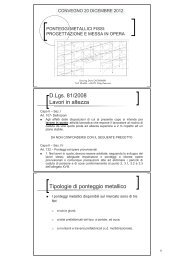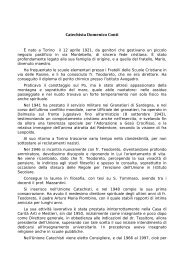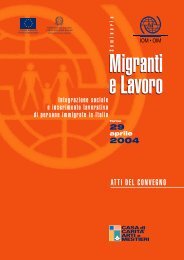Rapporto finale/ Final Report (ITA-ENG) - Casa di Carità Arti e Mestieri
Rapporto finale/ Final Report (ITA-ENG) - Casa di Carità Arti e Mestieri
Rapporto finale/ Final Report (ITA-ENG) - Casa di Carità Arti e Mestieri
Create successful ePaper yourself
Turn your PDF publications into a flip-book with our unique Google optimized e-Paper software.
Overall, the various tools used by the partners during the course of the project clearly served <strong>di</strong>fferent<br />
aims. Tools such as script writing, <strong>di</strong>scrimination boxes, questionnaires, watching films and videos<br />
and, to some extent, drama activities, were mainly used to raise pupils’ awareness about aspects of<br />
<strong>di</strong>scrimination and intolerance within society but also in in<strong>di</strong>viduals. Group <strong>di</strong>scussions, role play,<br />
video and drama productions also attempted to foster the exchange of ideas and develop abilities to<br />
act, that is the skills (for example, to interpret situations, meet challenges, master non-violent verbal<br />
and non-verbal communication) to enable them to understand and handle situations in which they<br />
are the victims of or witnesses to intolerance.<br />
This is a very important aspect to bear in mind when addressing similar issues. When working with<br />
young people to investigate the issue of <strong>di</strong>scrimination, it can be extremely effective to use of a variety<br />
of tools in order to develop their practical skills and foster comprehension and awareness of the<br />
problem. As highlighted by a number of researchers on this subject13 , you cannot teach against racism,<br />
perhaps it is not even possible to teach about racism, since through our characteristics and our<br />
in<strong>di</strong>vidual and collective experiences, we are all involved in one way or another. Anti-racism education<br />
must follow two essential lines: one lies within the sphere of reflection, the other in that of action.<br />
Acknowledging stereotypes, preju<strong>di</strong>ces and <strong>di</strong>scrimination is certainly an important aspect of antiracism<br />
education. But it is equally important to learn to react when faced with episodes of racism.<br />
In the <strong>di</strong>agram (the instrument board) that follows, we have attempted to reorganise the tools used<br />
along two axes. Along the vertical axis we have made a <strong>di</strong>stinction between the tools used in the<br />
Cross Community Schools (top two boxes) and those that were not used (or only partially used ) but<br />
which could be useful in future projects to investigate this issue (bottom two boxes).<br />
Along the horizontal axis we have made a <strong>di</strong>stinction between tools used to develop action skills<br />
(boxes on the left) and those aimed at fostering knowledge about the issue (boxes on the right). It is<br />
important to remember that the tools do not always serve exclusively to achieve one specific objective:<br />
for instance, drama workshops offer young people an opportunity to reflect on the problem and<br />
to acquire new skills to act and face up to <strong>di</strong>fficulties. Positions of tools along the horizontal axis are<br />
therefore approximate and not to be regarded as absolute.<br />
13 Eckmann, Davolio, op. cit., p. 36.<br />
70







